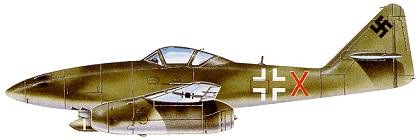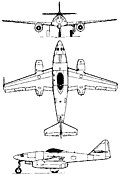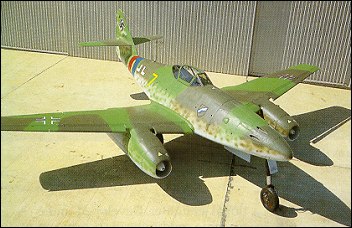|
| What would have been the outcome of the war in Europe if in 1940 the potential of Messerschmitt's Project 1065 had been appreciated by high authority? If a crash programme had been originated to put this turbojet-powered aircraft into service at a much earlier date, would the Luftwaffe have regained the initiative of the first two years of World War II?
Unfortunately the answers are not clear cut and there is no space here to discuss the pros and cons. It must suffice that the Me 262 (as the P.1065 became designated) was the world's first turbojet-powered aircraft to enter operational service - at Juvincourt, France on 10 July 1944. By then, however, the end of hostilities in Europe was only ten months away: the lack of a real plan for the deployment of these aircraft and the
inadequacy of tactics to gain full benefit of their' speed advantage could not be rectified in so short a time - especially under the chaotic conditions existing in Germany and with dwindling supplies of fuel .
Messerschmitt's P.1065 design had originated as early as 1938 when the Reichsluftfahrtministerium had requested the company to design a twin-engined fighter able to utilise the new turbojet engines being developed in Germany. After inspection of the mock-up, three prototypes were ordered on 1 June 1940. But because the engines to power the Me 262 had not been developed sufficiently, the first prototype flew initially with piston engines. It was not until 18 July 1942 that the first flight with all-turbojet power was recorded. (The Heinkel 280, which did not enter production, had flown before the Me 262, on 2 April 1941, so becoming the world's first twin-engined jet.)
Of conventional all-metal stressed-skin construction, the wing had moderate sweepback, long-span ailerons, trailing-edge flaps, and full-span automatic leading-edge slots. The engines were mounted beneath the wing to preclude a complex wing-spar structure and the landing gear was of retractable tailwheel type. The fifth prototype introduced a non-retractable nosewheel unit and the sixth was the first to have a fully retractable tricycle-type landing gear.
First major version was the Me 262A-1a Schwalbe (Swallow) interceptor, armed with four 30mm MK 108 cannon mounted in the nose. It was powered by two 8.825kN Junkers Jumo 109-004B-1 eight-stage axial-flow turbo-jets. A number of variants were built with differing armament. The other major version was the Me 262A-2a Sturmvogel (Stormbird) bomber. This was produced at the insistence of Adolf Hitler - a decision which caused considerable overall production delays. It carried, in addition to the standard MK 108 armament, one 1,000kg, two 500kg or two 250kg bombs. As with the Schwalbe, there were a number of variants, mainly for armed or unarmed reconnaissance.

| MODEL | Me-262A-1a |
| CREW | 1 |
| ENGINE | 2 x Junkers Jumo 004B-1/-2/-3, 8.82kN |
| WEIGHTS |
| Take-off weight | 6400 kg | 14110 lb |
| Empty weight | 3800 kg | 8378 lb |
| DIMENSIONS |
| Wingspan | 12.48 m | 41 ft 11 in |
| Length | 10.6 m | 35 ft 9 in |
| Height | 3.84 m | 13 ft 7 in |
| Wing area | 21.7 m2 | 233.58 sq ft |
| PERFORMANCE |
| Max. speed | 870 km/h | 541 mph |
| Ceiling | 11450 m | 37550 ft |
| Range | 1050 km | 652 miles |
| ARMAMENT | 4 x 30mm cannons |
 | A three-view drawing (1667 x 1123) |
| David Earl, 01.03.2011 23:22 I have to say, if hitler wasn't such an idiot and held scientific research, Nazi's would have had a good chance of defeating the allied air force, they would have lost to the nukes being made though. reply | | MAVERICKTOPGUN, 05.02.2011 05:12 ALL OF YOU DAMN FUCKIN' ANTI GERMAN CRAPPERS SHUT UP!!!!!!!!!!!! THE ME-262 KICKS ASS!!!!!!!!!!! reply | | Ron, e-mail, 13.01.2011 01:38 Though the comparison with the P-8o jet is tempting, I would consider it a generation newer. First line service for the Me 262 was about a year and a half earlier. Some say the 262 had bad roll rate. That's not what I've read. A full 360 degree roll in 3 seconds is quite good for a twin jet fighter in my opinion even if the P-80 did better.
The P-80 was effectively post-war.
The RAF Meteor was more contemporary jet with the Schwalbe. reply | | macc, e-mail, 26.12.2010 00:23 While the 262 was an advanced airplane in terms of speed, it was not as maneuverable as the piston powered fighters at the time. And while early deployement would have presented a problem for American and British bomber fleets, the arrival of the Lockheed P-80 would have ended the dominance of the 262 because the Lockheed fighter was far superior in all performance categories. In 1945 P-80s were in Italy, but never met the 262 in combat as the war ended in April /March of that year. reply | |
| | Olaf, e-mail, 06.11.2010 08:49 There is one surviving Me-262 night fighter, dubbed Red 08, at the South African Museum of Military History. Interesting plane, it is a two-seater with the night-fighter radar array on the nose. reply | | Zach, 18.10.2010 01:15 I have little doubt, that if the Me-262 had entered the war earlier, it would have decisevly changed the war. Especially since the germans would have made improvements to the bombers far earlier and made them to fast to hit. reply | | Ron, e-mail, 11.10.2010 08:28 Lou,
Up to 1,443 total built. Credited with at least 735 kills ,losses were around 120 if I'm not mistaken. 315 had been accepted by November 1944 with another 1,065 delivered by April 1945, only a fraction of which would see combat. Even if each Me 262 jet was worth 3 P-51s, it was outnumbered by far more. Before May 1945 it was a lost cause for these jet fighter units. The most successful jet pilot was Kurt Welter in an Me 262B-1a-U1 night fighter. He had at least 20 confirmed kills out of 30 claimed. reply | | Lou Peters, e-mail, 23.09.2010 06:36 I could not find in the documentation how many were built!!!
Their late entry in the war, few good pilots left, low fuel supplies and numbers were against them. How many were built???
Lou reply | | Ron, e-mail, 15.06.2010 23:01 I liked the 6x30-mm MK 108 cannon special. There was also the mixed 6 cannon jet with twin MK 103, twin MK 108, and twin MG 151 /20 for more spread and range. Of course they were rare but awesome. The missiles carried on the wings scored well against bombers too.
We tend to think Hitler is to blame for delaying this as a fighter but we know the immature jet engines were also as much to blame. Strategic materials required, were hard to come by. So development would have been slow anyway. The wonder weapon projects were so many, no doubt a crash program with 2 or 3 may have been a wiser use of resources, I agree. But it's more interesting for us with the variety.
Even as it was, the Me 262 Schwalbe (like the Tiger tank) enjoyed such a margin of superiority that comes along at times few and far between in history. So many jets are designed for one war but don't fight until the next one. That's not so here. reply | | Art Montana, e-mail, 03.06.2010 01:23 The "Planes of Fame" museum in Valle, Arizona was closed when I visited last week, but I thought that I spotted a ME262 rotting away in the back yard. Is this the case?
Thanks reply | | Kevin, e-mail, 15.04.2010 20:25 This plane shows how advanced the German effort was at the time. There was a lot of foresight in some of their thinking, and some really DUMB moves. Had they focused on things like this project, maybe it would have led to a different outcome. Then we might not have the financial crises in this country that we're all paying for.
Would love to see one of the 262-1c's fly. It has to have a great "wow" factor! reply | | Rich Ragle, e-mail, 08.04.2010 01:54 Still one of the best looking aircraft EVER made. Would have changed the out come of the war had Hitler not been an idiot. He delayed production of ME 262,,,and opened a two front war,,,which all his Generals said they couldn't win. Thank God for Narcissistic idiots! reply | | Bob Rosenberg, e-mail, 03.02.2010 23:39 Looking for assembly manuals and missing parts for the JUMO 004 as part of a restoration project at the New England Air Museum in Windsor Locks CT, Can any one help me out? reply | | Matt, e-mail, 31.01.2010 07:47 Possibly the best , as with the addition of an all moving tailplane , it could also have been the first supersonic fighter . [ Something the germans were working on ]
To bad the Nazis were such NUT jobs hu !!! and so short sighted . reply | |
| | Steve4570, e-mail, 16.01.2010 01:26 P-80 first prototype flew Jan 1944. The first operational P-80A's reached units Dec 1945. Vampire reached prototype stage Sept 1943, put into production Mar 1944, in service from 1946. My reference does not go into why the Vampire went into service so slowly. It suggests that the British limited themselves to perfecting their first jet (Meteor)so that the RAF would have an effective and continually updated weapon. reply | | Bob Fitzsimmons, e-mail, 01.09.2009 21:51 Forget the P-80 ,at the time in question it was just a prototype relying on a supply of British engines. If the allies had felt the need for a high speed jet the De-Haviland Vampire was already well developed and on paper at least more than a match for the 262. The Vampire was only 3 /4 the weight of the 262, larger wing area more heavily armed and reliable. The P-80s time would come ,but by the end of the European war the Vampire was the most advanced fighter in existance. I wonder why it was never used in anger? reply | | Leo Rudnicki, e-mail, 27.07.2009 19:32 The Me-262 WAS built in greater numbers. The throttle problems precluded their use in formations greater than the loose deuce. Fuel, or lack of it, also prevented large formations. Broken engines prevented large availability. Operating from airfields where swarms of Allied fighters held air superiority was another problem. It is a fact that had the Germans not been losing the war, they might have won. Of course, had the British listened to Sir Frank in 1929, we might be all speaking English today! And poor Pavel Sukhoi thought the configuration had merit. Uncle Joe didn't agree. reply | | John Whyte, 27.07.2009 17:50 I think if it was built in numbers it would change the tide of the war reply | | d.jay, 11.07.2009 00:41 The P-80 had the edge on the 262 because the engine of the P-80 did not blow up ever 5 minutes and kill more pilots and destroy more aircraft than it shot down. reply | | Leo Rudnicki, e-mail, 03.07.2009 03:30 The 50mm bk cannon was mounted in the nose on a bomber destroyer variant. The high speed of closure made firing time very short, and so rockets and the big guns. Speed range of the P-80 was comparable and throttle control superior. It was easier for an air superiority fighter to shoot down a heavily armed and armored bomber destroyer. reply |
|
Do you have any comments?
|
| 
COMPANY
PROFILE
All the World's Rotorcraft
|








